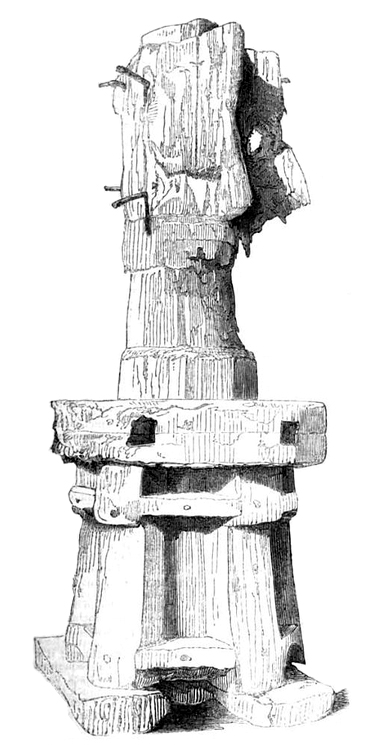Basil Hall
1839, 23 October (letter)
Capstan lately recovered from the Royal George
Book illustration, drawn with a camera lucida
Google BooksCapt. Basil Hall & Augustin Creuze, October 23, 1839, "Drawing and Description of the Capstan lately recovered from the Royal George",
Extracts from the Minutes of Evidence Given Before the Committee of the Lords on the London and Birmingham Railway Bill, (London and Birmingham Railway), vol. 2, pp. 3-5
Mr. Editor,I can have no sort of objection to your making the use you require of the sketch which I made with the camera lucida of the capstan lately recovered from the wreck of the Royal George. This portion of the wreck is particularly curious, as it furnishes at one view a specimen of the different effects produced by the lapse of the same interval of time, upon the same kind of materials, differently circumstanced with respect to exposure. It is now considerably more than half a century since the Royal George went to the bottom (strictly, fifty-seven years), and many persons have imagined that nothing belonging to her structure, or contained within her, could have retained its original character. The contrary, however, has been abundantly shown to those on the spot, and will, no doubt, be fully described to the public in the account of Colonel Pasley's masterly proceedings which you promise us. At present I have to do only with the capstan which, from its remarkable appearance so strongly engaged my attention, as to induce me to make the drawingan engraving of which you consider may interest your readers.
The lower portion, which appears to have been imbedded in the mud and clay ever since the ship went down, is not only entire in form, but seems to be so in texture and in strength. In proportion as we rise, however, the capstan loses this perfect character, for where it has been left without the protection of the mud, it has been acted upon by the worms, by the chemical action of the water, and by the unceasing friction of the tides. At first, these traces of the teeth of time are barely discerniblebut when they become more obvious, the organic character of the structure begins to lose its sharpness, till, at last, almost all traces of the original form are melted away. As the peculiar interest of this matter lies chiefly in the fidelity with which the details are given, I set myself to work, after I had made the accompanying sketch, to describe, minutely, the state of the different parts of the capstan. But I soon found that to do it any justice, much more knowledge of a technical nature was required than I could bring to bear upon it. In this dilemma, I applied to my friend, Mr. Augustin Creuze, an officer in Portsmouth Dockyard, and a gentleman already favourably known to the public, by his papers on naval architecture. He very kindly furnished me with the following minute and luminous description which, taken along with the sketch, will I hope enable your distant readers to form a pretty fair estimate of the singular effects of time on one of the most compact masses which arc to be found on board ship.
It is satisfactory to know that Admiral Bouverie, the superintendent of Portsmouth Dockyard, has taken measures to preserve this interesting relic, and to place it in such a position, and in such a light, that its several parts, and the extraordinary variety in the effects of time which it exhibits, may be distinctly seen. It would cost but little more trouble, and no expense, to fix the capstan on a swivel, like the statues in a museum, or, like itself in former days, in such a manner that it might be turned round, so that it could be viewed at every angle.
I hope you will allow me, once more, to call the attention of naval men to the great advantage of using the camera lucidaan instrument which confers a wonderful power of rapidly, and at the same time correctly, delineating any objectno matter how intricate the form, 01 complicated the perspective. I do not say that a person entirely unacquainted with drawing can use the camera, efficiently, all at once, and without any trouble; on the contrary, a good deal of patience and application are necessary to acquire any proficiency in its use. But I am convinced that I in no respect overrate its merits, when I say that one-tenth part of the pains generally bestowed, to very little purpose, in learning what is sadly miscalled " drawing," would enable the same persons to employ a camera lucida made by Dollond, with very useful effect. This arises from the accuracy which belongs to all its delineations, and which is quite consistent with the most perfect freedom of execution in the hands of those who possess taste or capacity to represent nature with spirit. Its chief advantage, however, lies in the power it confers on a person like myself, who knows little of drawing, who cannot, by any degree of effort, represent a complicated object correctly without this instrument, and to whom, though the rules of linear perspective are more or less familiar, the labour of applying them in a sketch is to the last degree irksome and discouraging. The use of the camera in such hands is a real source of pleasure, and its results may often he useful. The drawing of the Royal George's capstan, given on the next page, occupied me not quite three-quarters of an hour, yet, I will undertake to say it is as correct in all essential particulars as if it had been drawn by a professed artist.
I remain, &c.
Basil Hall
LL/56824
